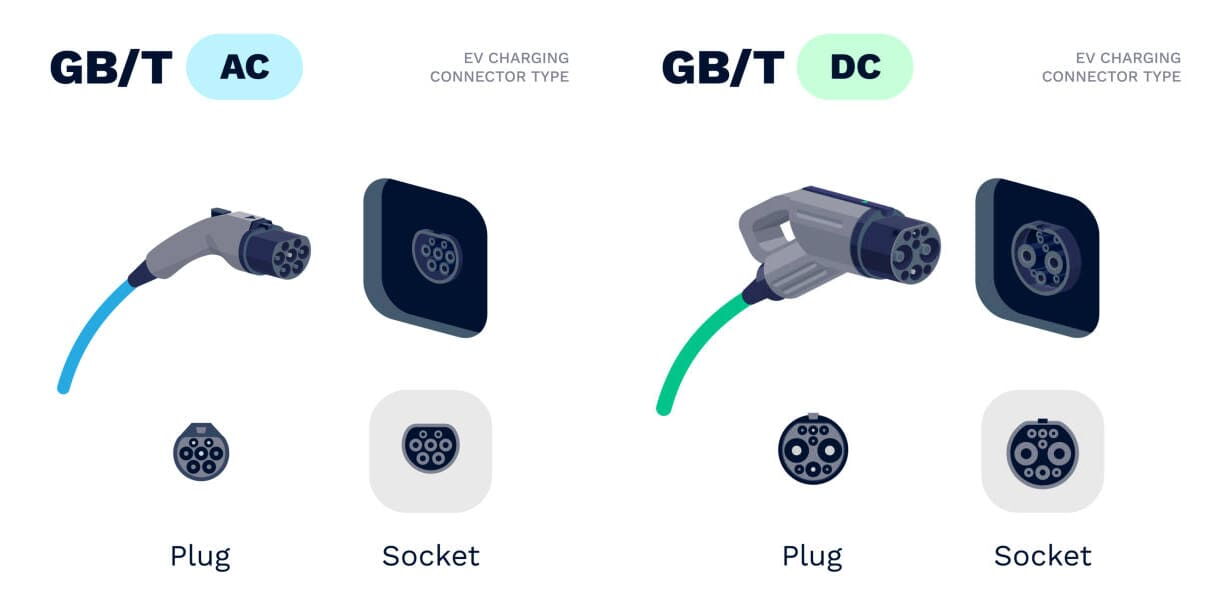As the world’s largest and fastest-growing market for electric vehicles (EVs), China has played a pivotal role in shaping the future of clean transportation. One of the cornerstones of this transformation is the GB/T charging standard—China’s official EV charging protocol. Governed by the Chinese government, the GB/T standard covers a range of operational, design, and safety requirements for both alternating current (AC) and direct current (DC) EV charging systems. It is an essential part of China's push to expand its electric vehicle infrastructure, support the mass adoption of EVs, and make its cities cleaner and more sustainable.

The GB/T charging standard stands out not only due to its scope but also because of its unique characteristics. Unlike other global charging standards, such as the Combined Charging System (CCS) in Europe or CHAdeMO in Japan, the GB/T standard has been designed to cater specifically to China’s market needs. It includes distinct connectors, communication protocols, and safety measures that differentiate it from international charging systems. As the Chinese government has invested heavily in EV infrastructure, this singular standard has helped streamline the charging process, ensuring that all electric vehicles (EVs) and EV charging stations can communicate effectively and operate smoothly.
The GB/T standard addresses both AC and DC charging, each with its own specifications and applications:
The AC version of the GB/T connector is generally used for slower, overnight charging. It provides power of up to 7.4 kW, making it suitable for home use or public stations with lower charging demand. In a country like China, where long-distance travel is common, having an efficient and widespread AC charging network ensures that drivers can easily recharge their EVs during off-peak hours, typically at home or in convenient locations like shopping malls or public parking lots.
On the other hand, the DC GB/T connector is designed for fast-charging applications, delivering high-powered outputs of up to 237.5 kW, depending on the model. DC fast chargers are crucial for long-distance travel, as they provide rapid recharging at highway charging stations and urban fast chargers. These chargers have become indispensable for EV owners who need to minimize downtime during long trips or in urban areas with a high volume of EV traffic. With rapid advancements in battery technology, DC chargers continue to evolve, offering faster charging times to meet the growing demand for EVs across China.
Unlike Western markets, where dual-standard charging systems like CCS (which combines both AC and DC charging capabilities into one connector) are the norm, China’s exclusive adoption of the GB/T standard ensures a unified infrastructure for the nation’s EV ecosystem. This has made China’s charging network one of the most efficient and consistent in the world, as all EVs in the country are designed to be compatible with the same connectors, ensuring ease of use and accessibility.

One of the defining features of the GB/T standard is its robust communication protocol. This protocol facilitates a seamless connection between the electric vehicle and the charging station, ensuring that both devices can exchange vital data throughout the charging process. The protocol allows real-time monitoring of key charging parameters, including current, voltage, and temperature.
This real-time communication is vital for several reasons:
Continuous monitoring ensures that any irregularities, such as overheating or overcurrent, are detected immediately, preventing potential hazards and protecting both the vehicle’s battery and the charging infrastructure.
By optimizing charging parameters based on the vehicle’s battery management system, the protocol helps reduce energy waste and ensure that the charging process is as efficient as possible.
Real-time data enables users to track their charging status, providing transparency and confidence in the process.
Moreover, as part of China’s stringent regulatory framework, the GB/T standard is designed to ensure that all charging stations and EVs conform to high safety and performance standards. This not only safeguards users but also enhances the overall reliability of the EV charging network.
China’s adoption of the GB/T standard has been central to the rapid growth of its EV market. The government’s support for the EV sector, including heavy investments in charging infrastructure, has made EVs increasingly accessible to a wide population. According to various industry reports, China has become the global leader in EV production and sales, with millions of electric vehicles now on its roads. This success has been underpinned by the GB/T standard, which provides consistency and reliability in the nation’s EV charging infrastructure.
The Chinese government’s strong backing has also led to a substantial increase in the number of charging stations nationwide, making it easier for EV owners to access charging points. The establishment of charging networks using the GB/T standard has helped reduce “range anxiety” for Chinese consumers, who now have the confidence to drive EVs without worrying about charging availability.
In addition to supporting domestic EV adoption, China’s investments in the GB/T standard have also had a broader impact. As the world’s largest EV market, China’s approach to standardization has influenced EV policies and charging infrastructure development in other emerging markets, particularly across Asia. Countries like India, which are also experiencing rapid growth in electric vehicle adoption, are looking to China’s model as they develop their own EV ecosystems.
The GB/T standard addresses several critical areas to ensure the safe, efficient, and reliable operation of electric vehicle charging systems:
One of the most important aspects of the GB/T standard is its focus on safety. The protocol includes overcurrent protection and temperature monitoring to prevent hazards such as fires or electrical failures. With the growing number of electric vehicles on the road, ensuring the safety of charging stations and their users is paramount. By adhering to strict safety standards, the GB/T standard minimizes the risk of accidents, fostering greater confidence among consumers.
The GB/T standard supports high-voltage and high-current capacity, enabling the rapid charging of electric vehicles. By establishing charging specifications that allow for high-power delivery, the standard makes it possible for EVs to be charged quickly, reducing downtime and making long-distance travel more feasible.
As mentioned earlier, the communication protocol ensures that the vehicle’s battery management system and the charging station can exchange data in real-time. This is essential not only for safety and efficiency but also for optimizing the charging experience for users. It enables the monitoring of key charging parameters, helping to prevent overcharging and maintain battery health over time.
The GB/T standard plays a crucial role in the future of China’s EV landscape. As the nation continues to lead the global EV revolution, this standard has several important implications:
The adoption of a single, national standard ensures that all EVs and charging stations in China are fully compatible with each other. This uniformity simplifies the charging process for consumers and reduces confusion for EV owners and infrastructure developers.
The GB/T standard is a driving force behind China’s rapidly expanding EV charging infrastructure. With more than a million EVs on the road and millions of charging stations planned, the standard is ensuring that the growth of charging infrastructure keeps pace with the increasing demand for EVs.
China’s success in standardizing its EV charging infrastructure through the GB/T standard is likely to influence other nations as they develop their own electric vehicle markets. By setting a precedent, China’s approach is shaping the global conversation around EV charging standards and infrastructure development.
The GB/T charging standard is a vital component of China’s electric vehicle ecosystem. By providing a clear and unified framework for both AC and DC charging, it ensures compatibility, safety, and efficiency for users across the nation. With its focus on real-time communication, high-powered charging, and robust safety protocols, the GB/T standard is helping to propel China’s EV market forward, positioning the country as a leader in clean transportation and sustainable energy. As other regions look to expand their own electric vehicle infrastructures, China’s success with the GB/T standard may well serve as a model for the future of global EV charging systems.
